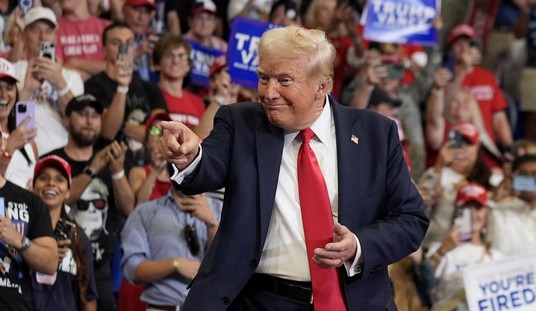![Republican Presidential candidate [mc_name name='Sen. Ted Cruz (R-TX)' chamber='senate' mcid='C001098' ], R-Texas, left, talks with former Arkansas Gov. Mike Huckabee, center, and Louisiana Gov. Bobby Jindal, right, while backstage before speaking during the Homeschool Iowa's Capitol Day, Thursday, April 9, 2015, in Des Moines, Iowa. (AP Photo/Charlie Neibergall)](https://redstate.com/uploads/2015/12/Ted-Cruz-and-Mike-Huckabee-600.jpg)
A closer look at the Republican primary calendar and its arcane delegate-apportionment rules suggests that a long nomination fight is likely to work against Ted Cruz unless he can compile a big delegate lead that cripples his opponents by the March 1 “Super Tuesday”/”SEC Primary”. That doesn’t mean Cruz can’t win; it does suggest why he may have a tougher road than [mc_name name=’Sen. Marco Rubio (R-FL)’ chamber=’senate’ mcid=’R000595′ ] (his most likely adversary if this race goes deep into April and beyond), but also why Republicans should be more reassured by Cruz’s general-election odds if he manages to run the gauntlet of the primaries as presently designed.
Presidential primary strategies come in two varieties: momentum strategies and delegate strategies. The former are mostly what we see in the fall and through the early round of primaries, which this year means the four states voting in February (Iowa, New Hampshire, South Carolina and Nevada): strategies designed to winnow the field by convincing voters, donors and opposing candidates that you’re a winner and your opponent has no chance and should give up. They are the electoral equivalent of shock-and-awe barrages designed to break the enemy’s will to fight from the outset and scatter his forces. Every election sees these strategies employed to eliminate all but a few candidates; in many, the nomination is eventually decided when it becomes obvious that the trend will favor one candidate.

Cruz, trailed closely by Rubio, has the most momentum right now in the polls, as judged by comparing today’s national, Iowa and New Hampshire poll averages to where the field sat on Labor Day. And there’s a lot more ahead before the delegates start to matter. But sometimes, there are two (sometimes three) candidates with enough momentum to go all the way to the convention, as happened most dramatically with the Obama-Hillary race in 2008 and the Ford-Reagan race in 1976 (and to a lesser extent Mondale-Hart in 1984). In those races, it actually matters how and when different states award delegates. Let us turn to the Republican delegate calendar and see how that happens this year.
Understanding The Rules
We do not have a single national primary, or even a single set of rules; rather, delegates are awarded by the 50 states, the District of Columbia, five territories, and the party’s uncommitted “superdelegates” – effectively a 57-state process (this was undoubtedly what Barack Obama had in mind when he made his famous “all 57 states” gaffe during the 2008 delegate chase). While each of these 57 electorates has its own unique political geography, there are five major fissures worth analyzing in how they interact:
1) When each primary or caucus is held;
2) The state’s overall political bent;
3) Whether the state holds a primary or a caucus;
4) Whether the state has an open or closed primary; and
5) How the state awards delegates.
1. The Calendar

I walked through a version of the calendar above back in October to estimate how and when it would narrow the field, and linked to the invaluable summary from The Green Papers regarding the delegate-allocation rules for accumulating the 1236 out of 2472 delegates needed to secure the nomination at the Republican National Convention July 18-21. As you can see from the above, the primary calendar starts a month later this year than it did in 2012, while the convention is a month earlier, and over half of the delegates are awarded in a single month (March).
The main significance of timing is that there are still 14 candidates in the race, of the original 17; that’s why any candidate over 20% is a threat to win an early state like Iowa or New Hampshire. By contrast, only one modern GOP nominee ([mc_name name=’Sen. John McCain (R-AZ)’ chamber=’senate’ mcid=’M000303′ ] in 2008) won the nomination with less than 50% of the overall primary vote, and McCain got 47.32%. Partly that’s a feature of sweeping states at the end once the race is no longer contested, but even in 2012, Mitt Romney got 40.5% of the vote in January, 40.6% in February, 37.6% in March and 45.4% in the early April states before Rick Santorum threw in the towel.
As we go deeper in the primaries, more candidates will drop out (we’ll probably be down to no more than 7-9 candidates after New Hampshire, maybe 5 or 6). What’s significant is that many of the states in the early going award delegates more or less proportionally – so, if you’re likely to win a state, you’d much rather win it after it’s down to a 2 or 3 or 4 candidate race rather than a 14 candidate race.
2. Red State, Blue State, Purple State
Not every state’s electorate is the same. My early-April analysis of the 2012 primaries, for example, found that Romney won 46.7% of the vote in “blue” states, 41.8% in “purple” states, but just 30.2% in “red” states, where Santorum and Newt Gingrich combined for about two-thirds of the vote.
The reason is not hard to see. Republicans in states that rarely vote R in national elections may be more moderate to start with, and furthermore are conditioned by their experience in statewide races to see the most conservative candidates as less electable. By contrast, Republicans in safer deep-red states have had more positive experience with Tea Party primary winners and the like.
And the blue states and districts (districts matter, as we’ll see) have an advantage: for reasons explained by Dave Wasserman at 538, the way the rules are written give more weight to the votes of blue-district Republicans:
The average blue district awards one convention delegate per 28,912 Romney [general election 2012] voters, while the average red district awards one delegate per every 56,714 Romney voters. Thanks to this disparity, if a hard-right candidate like Cruz dominates deeply red Southern districts in the SEC primary, a more electable candidate like Rubio could quickly erase that deficit by quietly piling up smaller raw-vote wins in more liberal urban and coastal districts.
The RNC partially compensates for this imbalance in the way it awards delegates on a statewide basis. Republicans award “bonus” delegates to states with lots of GOP officeholders and states with the best GOP performance in the last election. For example, despite both states having nine congressional districts, Tennessee will send 58 delegates to the Cleveland convention while Massachusetts will send 42.
For purposes of my analysis, I’m counting as “red” the states that Romney & McCain both carried against Obama (plus Indiana, which was a fluke Obama win in 2008), and as “blue” the states that both Kerry and Gore carried against Bush (plus New Mexico, which was a fluke Bush win in 2004). The rest are “purple,” plus the territories.
3. Primaries vs Caucuses
There’s also a big difference between primaries and caucuses: the latter feature much lower voter turnout, due to their time-consuming nature, and tend to attract mainly committed activists, a dynamic that helps more conservative candidates as well as people with particular ideological or religious factions committed to their cause (ranging in past years from the Ron Paul crowd to the Mormon vote for Romney).
In 2012, for example, through the last competitive vote on April 3, Romney had won 39.8% of the vote in states holding primaries, Santorum 28.1%, Gingrich 20.5%, and Ron Paul 10.1%; in caucus states, Romney dropped off to 30.8% and the poorly-organized Gingrich plunged to 11.0%, while the more cohesive social-conservative Santorum vote held nearly steady at 27.6%, and the Paul vote surged to 18.8%.
4. Open vs Closed
Not every state’s primary is limited to Republican voters; instead of a closed primary, many states have either an open primary (in which any voter can vote so long as they’re not voting the same day in a different primary) or a “modified” primary in which anyone who doesn’t belong to any other party (i.e., independents) can vote. It’s debatable exactly how large the independent vote may be, but there are precedents for open primaries favoring more moderate candidates, the 2000 GOP primary being a notable example; some exit polls found that as many as 17% of voters in Republican primaries that year were Democrats, and that seems to have been a major assist to John McCain:
In New Hampshire, McCain won 53 percent of independents – who accounted for 41 percent of the votes cast in the Republican primary, according to exit polls. In South Carolina, where he lost, McCain got nearly 80 percent of Democrats who voted and 60 percent of independents.
In Michigan, 45 percent of McCain’s votes came from independents and 29 percent from Democrats, according to exit polls. By contrast, Bush led by more than 2-1 among Republican voters.
Of course, if the matchup is Cruz v Rubio, independent voters may just stay away, seeing little difference between the two.
5. Delegate Allocation
The most complex part of the process is how states allocate delegates. The simplest ways are the Winner-Take-All (WTA on the charts below) states, where the top finisher gets all the delegates, and the Proportional states (“PROP”), where delegates are proportional to each candidate’s share. If you expect to finish first, you’d want a WTA method; if you’re expecting a lot of strong seconds and thirds, or simply trying to slow down the frontrunner, you’d be happier in a PROP state.
But some states also award delegates by House district as well as statewide; states listed as WTAD/WTAS indicate states that do this. These are still good states for the winner, although a candidate stronger in some districts can steal some delegates (Ben Carson, for example, has been assiduously courting black support in majority-black districts that have few Republicans – there are many such districts in the Deep South). Some states award delegates on a “Winner-Take-Most” (WTM) or “Loophole” basis, methods that defy easy description but effectively result in the winner getting the bulk of the delegates. (You can go here for the Green Papers effort to explain these intricacies). Some use a proportional formula that can be overridden to a winner-take-all if one candidate gets over 50% of the vote (“PROP/50+”). New York, for example, uses this method on both the district and state levels, while Virginia does it on the state level while awarding delegates on a winner-take-all basis on the district level. Some states use a “Caucus/Convention” or “Delegate Selection” method, in which voters pick the delegates – in practice these tend to be proportional states, although the degree to which the delegates are bound and free to switch at the convention may vary. Finally there’s Colorado, whose delegates will be complete free agents at the convention, as well as 138 superdelegates, who will likewise be up for grabs, however much they may be swayed by the votes in their states. The free delegates are not a large number, but at a minimum they could tip a close race to whichever candidate is less objectionable to the party establishment. In a choice between Rubio and Cruz, these are likely to prefer Rubio, although many may feel pressure to support whichever is the popular-vote winner. In a choice between one of those two and Trump, they will almost certainly line up all but unanimously against Trump.
The 2016 Map
How this plays out in this primary depends a good deal on how these various factors interact, but also on who the candidates are. There may not be a conventional moderate in the race’s endgame – Chris Christie is probably in better shape right now to claim that vote than Jeb Bush or John Kasich, but all three are potentially extinct after New Hampshire if they don’t finish in the top two there (Jeb may have enough cash and stubbornness to stick around through March 1). If the race comes down to Rubio against Cruz, the moderates likely line up behind Rubio. Carson, as noted, may be able to draw on some non-Republicans by courting black voters (including some who may not be persuadable even for Carson in November, but who see little difference between Hillary and Bernie Sanders), but then, Carson has been fading of late. By contrast, if Rubio and/or Cruz faces off against Trump, Trump’s appeal to disaffected independents could become a factor (it almost certainly gives him a boost in New Hampshire).
But either way you slice it, the candidate who will rely most heavily on conservative Republicans for his support is Cruz, whose whole political brand is wrapped up in being the more-conservative-than-thou Republican. Without disparaging the possibility that Cruz could energize and register new voters in the general election, and the fact that he may have some support among Tea Partiers who have dropped the R label in disgust, the simple fact is that people who prefer Cruz to the other GOP contenders are disproportionately likely to already be registered Republicans of a conservative, red-state variety, and thus the smaller their influence on the ultimate nomination, the worse things are for Cruz.

At first glance, the breakdown looks pretty encouraging for a candidate with Cruz’s profile: red states select 41.9% of the delegates, more than blue states do, and closed primaries are also almost half the total, 46.8%. I list under “WTM” here all the states that use a district-by-district delegate selection, since those are all states that can’t guarantee a winner the full slate; “Other” here is the Convention/Caucus states and the like.
The Red States


But a closer look at the red states signals trouble. Guess how many red states are winner-take-all with a closed primary or caucus? Two, the Arizona primary and the Montana caucus, and the latter is on June 7, the final day of voting. One other, the Oklahoma primary, is winner-take-all by both state and district with a closed caucus – that’s on March 1. The fact that more than half of the red states have open or partly open caucuses could spell trouble if Trump is still in the running. Seven red states awarding delegates more or less proportionally or by convention vote between March 1 and March 8, most of them in or around the South – Tennessee, Mississippi, Louisiana, Kentucky, Kansas, Alaska, and Wyoming – and Carson and Huckabee are likely to be well-organized enough in those states to siphon off some delegates if they’re still running (that seems delusional on Huckabee’s part, but he has spent a lot of time talking up a SEC Tuesday strategy).
By far the biggest delegate prize, Cruz’s home state of Texas, shifted away from a proportional method, but is still a winner-take-most state with an open primary, weakening the hammer blow that Cruz can expect to drop on March 1. The closed red states are heavily caucuses, which might favor Cruz, but at least one of those (Kentucky) could still draw a big vote for favorite son [mc_name name=’Sen. Rand Paul (R-KY)’ chamber=’senate’ mcid=’P000603′ ] if he’s still in the race on March 5. And after March 8, most of the red states are off the calendar.
The Purple States


The purple states, fittingly, include three of the four February states, and three of the other four vote on March 15, including Rubio’s home state of Florida. Note that these states are tilted more towards the winner – Florida and Ohio are both winner-take-all (both have been won by every nominee back to 1976), and Florida is closed, meaning Trump-backing independents can’t poach on Rubio’s turf.
The Blue States


Then we get to the blue states, and you begin to see how the calendar is structured to provide a firewall in a close race in favor of a more moderate candidate (even, as we may see with Rubio vs Cruz, a candidate who is really only very slightly more moderate, or rather more appealing to moderate voters). Many more of these are closed primaries, but few of them are proportionate, and most are tilted late in the calendar, so by design the winner will rack up most of the delegates (although there are many more winner-take-most or district-by-district than winner-take-all). Only a few are open, and in one of those (Vermont) the state’s non-Republicans will probably be lining up for Bernie Sanders.
The Territories


Finally, there’s the territories – just 44 delegates, but almost half of those are in the open Puerto Rico primary, where a Spanish-speaking candidate like Rubio (or in theory Jeb) should have a natural leg up.
Is The Right’s Man The Right Man?
In other words, if Ted Cruz is going to be the GOP nominee in 2016, not only does he have to run the gauntlet of Rubio, Trump and Carson, but he will need to break through and win a respectable share of the delegates from places like Florida, Ohio, California, New York, New Jersey, Pennsylvania, Illinois, Wisconsin and Michigan. That means a red-state-only and closed-caucus strategy might well get Cruz a lead by March 1 – but if he hasn’t knocked out the credible alternatives (mainly Rubio) by then, he will inevitably have to prove the very thing that has just-win-baby Republicans most worried: that he can expand his base beyond committed conservatives.
Ted Cruz will have to be more than Right to be President.













Join the conversation as a VIP Member